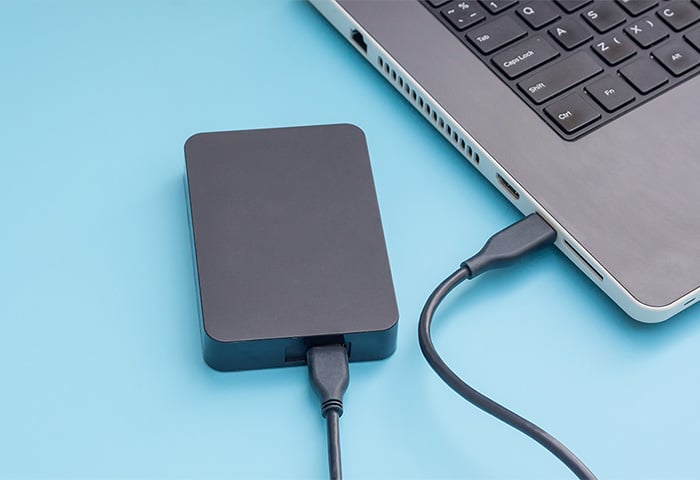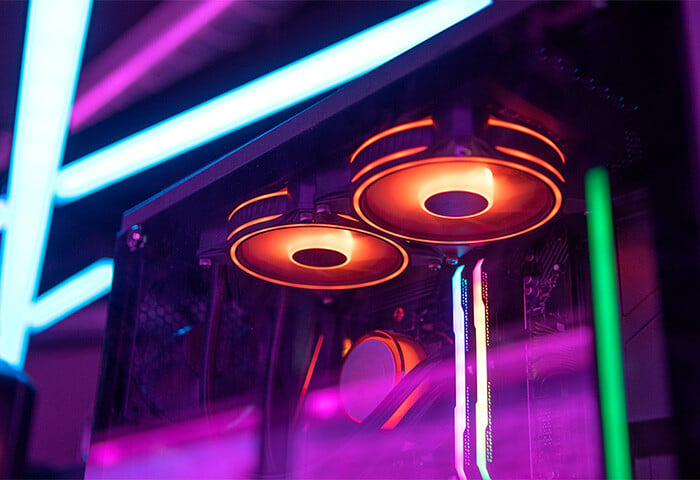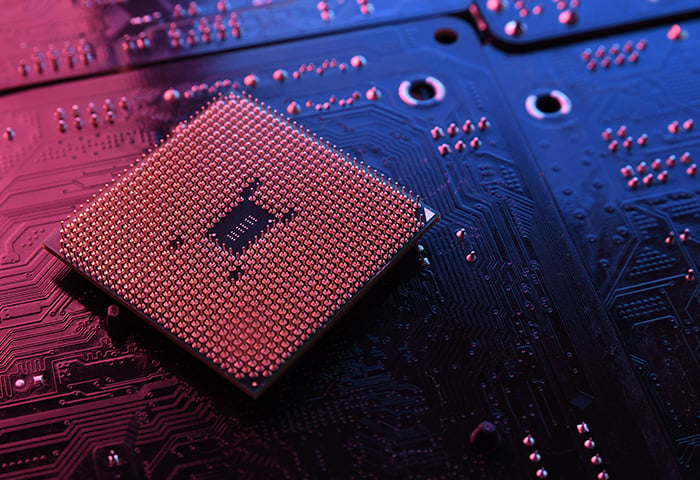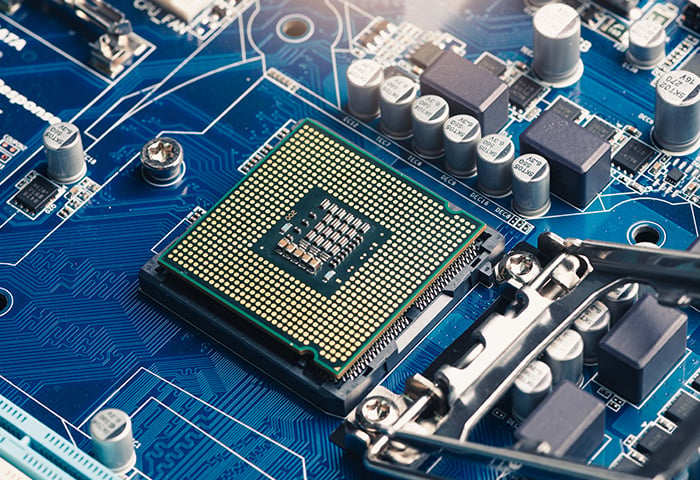What is a CPU stress test?
CPU stress tests, also known as CPU load tests, involve running a computer’s central processing unit at maximum capacity for a sustained period to evaluate performance and stability. They’re performed with stress testing software, which uses a variety of techniques to maintain your CPU at 100% utilization for an hour or more so you can gather data and get useful insights into your CPU’s performance.
The CPU is the most important integrated component of a computer, responsible for the main processing tasks. Measuring its performance under max load can help you evaluate how much your computer can handle and, by extension, whether your CPU is suitable for your needs.
How to run a CPU stress test in 6 steps
Running a stress test involves thorough preparation, including backing up data, updating software, and ensuring proper cooling. To get started, you’ll also need to install a reputable stress testing tool like Prime95 or HeavyLoad, and software to monitor system metrics as you run the test.
Read on for a step-by-step guide to running a CPU stress test and tips on how to review the results to evaluate your CPU’s stability.
1. Prepare your PC for a stress test
To make sure your CPU stress test runs properly, you need to prepare your PC by closing all non-essential apps, checking your CPU temperature, backing up any important data, and ensuring cooling systems, firmware, and drivers are all up to date and working properly.
Back up important data
A stress test puts a lot of pressure on your PC, which can occasionally cause system instability, crashes, or hardware failure. To protect your valuable files, back up important data beforehand.
You can back up data on a Windows PC through File History — a built-in backup tool that automatically saves copies of your files to an external drive or network location. Here’s how:
-
Connect your external drive via USB.
-
Go to Settings > Update & Security > Backup > Enable File History.
-
Select your drive and configure the folders you want to back up.
You can also use a cloud storage solution to back up your data in the cloud. Here’s how to do it using Microsoft OneDrive:
-
Open the OneDrive app and sign in using your Microsoft account credentials.
-
Drag and drop files you want to back up into the OneDrive folder.
If you’re on a Mac, you can back up your data using macOS's built-in backup tool — Time Machine:
-
Connect your external drive to your Mac.
-
Go to System Preferences > Time Machine > Set up automatic backups.
You can also back up your Mac data to iCloud:
-
Go to System Settings, then Apple ID.
-
Choose iCloud and enable file syncing.
You can also use third-party services like Google Drive or Dropbox for cloud storage, or manually copy important files to an external drive or USB stick for a physical backup. Both options provide added security and easy file recovery.
Update system software, drivers, and firmware
Updating software, drivers, and firmware can help your system run smoothly and avoid crashes during the stress test. It can also improve CPU performance, ensure compatibility with stress testing tools, and provide more accurate CPU test results.
Here’s how to check and run system software, driver, and firmware updates:
-
Go to the updates section of your operating system's settings menu (Windows Update or Mac's Software Update) and install available updates.
-
Update any outdated drivers via your system settings or use a driver updater. Mac drivers are usually updated automatically after updating the operating system.
-
Visit your device manufacturer’s website to download and install the latest firmware version for your hardware.
-
Reboot your computer to make sure all new updates are applied.
 AVG Driver Updater will scan for out-of-date drivers for you.
AVG Driver Updater will scan for out-of-date drivers for you.
Simplify updating your drivers with AVG Driver Updater. It scans millions of available drivers to find any you’re missing, eliminating the need for a time-consuming manual search. With its user-friendly interface, you can update outdated or broken drivers, fix issues, and restore your computer’s optimal performance in just a few clicks.
Close all non-essential applications and background processes
To prepare for your stress test, you also need to close any programs that won’t be used during the test, such as web browsers, games, or streaming apps. You can use AVG TuneUp to identify any programs wasting RAM and CPU resources and halt all background activity on your PC.
Here’s how to stop non-essential programs using AVG TuneUp:
-
Download, install, and launch AVG TuneUp.
-
Click Run Scan and wait for the scan to finish.
-
Go to Manage programs, then Sleep Mode.
-
Use the toggle button to temporarily sleep any listed programs you want to disable.
 Put your programs to sleep with AVG TuneUp’s Sleep Mode.
Put your programs to sleep with AVG TuneUp’s Sleep Mode.
AVG TuneUp's Sleep Mode feature detects potentially unnecessary programs and allows you to temporarily deactivate them to ensure your PC devotes all its resources to the CPU stress test. Try it for free today to help manage your programs and clean up your PC.
Ensure your cooling system is working properly
Stress tests push your PC hardware to maximum capacity, which generates a lot of heat. If your PC overheats, it can damage hardware components, so it’s important to check your cooling system is working properly before running a stress test.
Here’s how to check and maintain your cooling system:
-
Clean fans and heatsinks: Inspect your CPU fans, case fans, and heatsinks for dust buildup, and carefully clean them with compressed air.
-
Reapply thermal paste: If your thermal paste appears dry, cracked, discolored, or hardened, then clean it off with isopropyl alcohol and apply a fresh, pea-sized amount to the CPU.
-
Improve airflow: Organize cables with ties or sleeves and space out components inside the case. Ensure there’s adequate space around your PC for proper ventilation.
-
Check CPU temperature: Use temperature monitoring software like HWMonitor or Core Temp to check the temperature of your CPU. Do not perform a stress test if the reading is 194°F (90°C) or higher as this can cause thermal throttling.
If your cooling system is inadequate — with CPU temperatures reaching over 194°F (90°C) and frequent system crashes — consider upgrading to a more efficient cooling solution, like a high-quality air cooler or liquid cooling system.
If you need to upgrade your laptop’s cooling capabilities, applying thermal paste and cooler system upgrades may be unfeasible due to the compact components. Instead, try cleaning the external fans, using a laptop stand for improved ventilation, or using laptop cooling pads.
Plug your device into the mains
CPU tests are demanding on your power supply. If you’re running a CPU stress test on a laptop, plug your device in to ensure a stable power supply during the CPU stress test. This can help prevent interruptions from power loss or battery depletion, minimizing the risks of test failures or inaccuracies.
Run a quick device cleanup
Regular file maintenance and device cleanups benefit all computers and can be especially useful before a stress test, as unnecessary files take up storage space, drain CPU power, and slow performance.
AVG TuneUp automatically removes junk files and software, minimizes background activity to conserve CPU power and RAM, and keeps your PC running fast — ideal for running a stress test.
Here’s how to run a device cleanup with AVG TuneUp:
-
Download, install, and launch AVG TuneUp.
-
Select Run Scan. Once complete, review the suggested actions.
-
Click Clean Now to remove junk files, clear caches, suggest apps to remove, and optimize your system.
 AVG TuneUp automatically scans your device for clean-up options.
AVG TuneUp automatically scans your device for clean-up options.
2. Use a reputable CPU stress test software
Now that you’ve prepared your computer, you’ll need a dedicated stress testing program to run an effective CPU stress test. There are a number of popular options, most of which work similarly, including Prime95, AIDA64, HeavyLoad, and Intel BurnTest. Before downloading any software, check the reviews and make sure it’s from a reputable developer.
Here’s a more detailed look at some of the best options for CPU stress test software.
Prime95
Prime95 is one of the most popular CPU stress testing tools due to its ability to push a processor to its limits. It uses the Mersenne prime technique, which makes nonstop use of your processor’s floating point unit (FPU) and integer capabilities by providing complex calculations while also testing memory storage and retrieval performance across its various caches (L1, L2, L3). Prime95 is available for both PC and Mac.
AIDA64 Extreme
With over 25 years in the industry, AIDA offers a large suite of tools to display and diagnose your entire machine. AIDA64 Extreme is a premium product but comes with a 30-day free trial for a quick PC stress test. AIDA64’s system stability test simulates a realistic workload for your computer. It also offers benchmark comparison, allowing you to measure your PC’s performance against similar systems.
HeavyLoad
HeavyLoad is a free tool that allows you to stress test your CPU and monitor your GPU temperature as your computer is put through its paces. It displays real-time graphs of component usage, making it easier to monitor performance during the stress test. Its intuitive interface and straightforward design make it a good option for beginners or users who don’t require the advanced configurations offered by tools like AIDA64.
Intel Burn Test
Intel Burn Test isn’t an official Intel tool but is supposedly used by Intel to test its own products before launch. It offers one of the fastest and most intense methods to evaluate CPU stability. And, despite the name, the tool works on most modern CPUs, including those made by AMD and Intel. The program is lightweight and simple, using Linpack benchmarking to push processors to their limits, making it ideal for checking performance after overclocking your CPU or installing upgrades.
OCCT124
OCCT (OverClock Checking Tool) is a comprehensive stress-testing and monitoring utility that can test various PC components, including your CPU, GPU, power supply, and memory. OCCT124 is a portable executable file, requiring no installation — simply double-click the downloaded file to start. This simplifies diagnosing issues without cluttering your system with unnecessary software. The free edition offers access to all essential tests with minimal limitations, ensuring it can handle most diagnostic needs on Windows PCs.
Cinebench
Cinebench is a popular and free benchmarking tool developed by Maxon. It’s primarily used for assessing CPU and GPU performance but also offers CPU stability testing. Cinebench works on both Windows and macOS.
3. Set up monitoring tools
Stress test tools don’t always provide detailed results, so it’s crucial to set up additional CPU monitoring to effectively track temperatures, usage, and performance metrics. This will help you get maximum value from the test, giving you insights into your processor's stability and overall performance, while also helping you spot if your CPU is at risk of overheating so you can safely abort the test.
Here are some popular CPU monitoring tools:
-
HWiNFO: This comprehensive tool tracks CPU and GPU temperatures, voltages, and fan speeds. HWiNFO is reliable, easy to use, and supports a wide range of hardware.
-
Core Temp: Focused on CPU temperature monitoring, Core Temp provides real-time temperature readings for each core and is ideal for checking heat levels during stress tests.
-
Intel Extreme Tuning Utility (XTU): This official Intel tool offers detailed metrics and customizable settings that are perfect for both monitoring CPU temperature during a stress test and tuning CPU performance.
-
CPU-Z: A popular tool for displaying detailed information about your CPU, RAM, and motherboard, CPU-Z is lightweight, easy to use, and provides real-time performance monitoring.
-
iStat Menus (Mac): A Mac-specific tool that tracks CPU usage, temperatures, and overall system performance during a stress test. iStat offers customizable monitoring in the menu bar and is great for detailed system insights.
4. Start the stress test
Now that you've prepared your PC, installed the stress test software, and set up your monitoring tools, you're ready to start the stress test to evaluate your CPU’s performance. Most stress test software tools have unique features and processes, although the general process for running a test is similar.
-
Open the program, go to the test section, and choose your preferred test type such as CPU, GPU, or system stress.
-
Select test parameters like intensity, duration, and monitoring options to suit your needs, and then click Start or Run Test.
-
Monitor your CPU’s temperature, clock speeds, and voltage using your chosen monitoring software.
Below are step-by-step guides to using some of the most popular stress testing tools.
Using Prime95
-
Open Prime95, select Just stress testing, and then choose your preferred test type (Small FFTs tests your CPU in isolation, Large FFTs also tests your RAM, and Blend tests all components at once).

-
Let the stress test run for about an hour. Your processor will start working immediately, likely reaching 100% capacity relatively quickly.
-
Monitor your CPU temperature as the test runs and, when you’re ready to end it, click Test > Stop to end the stress test.
Using AIDA64
-
Open AIDA64 Extreme and click Tools > System Stability Test > choose your stress test(s) > Start.

-
Switch back to the main AIDA64 window and go to Computer > Sensor. Here, you can watch over the CPU temperature and see how fast your fans are rotating.
-
Let the test run for approximately an hour, monitoring your CPU’s performance and temperature, and click Stop when you’re ready to end the test.
Using HeavyLoad
-
Open HeavyLoad and select CPU Usage > Play.
-
Let the test run for about an hour, monitoring your CPU’s temperature and stability, and click Stop to end the test when you’re ready.
Using Intel Burn Test
-
Open the Intel Burn Test app and click Stress Level > Maximum > Start to begin the CPU load test.
-
Let the test run for about an hour while monitoring your CPU stats to see how your PC handles the stress. Click Stop to end the process when you’re done.
5. Monitor your system
Monitoring your CPU during a stress test ensures it operates safely within temperature, voltage, and clock speed limits. Watch for red flags like temperatures exceeding safe levels, significant clock speed drops (throttling), or unstable voltage. These could indicate cooling issues, instability, or potential hardware risks requiring immediate attention.
Track CPU temperature
Using your selected CPU monitoring tool, check the maximum temperature your CPU reaches during the test, as well as the average temperature over the course of the test. These measures help you gauge if your cooling solution is sufficient. Keep an eye on temperature fluctuations — rapid spikes may indicate cooling issues or potential hardware problems. Stop the test if the maximum temperature exceeds 194°F (90°C).
Track clock speeds
CPU clock speed shows how fast a CPU processes tasks and is measured in gigahertz (GHz). Tracking clock speeds during a stress test helps you verify if your CPU is operating at its expected frequency under load or stress. It can also reveal if your CPU is throttling due to overheating or power limitations. Higher clock speeds usually mean better performance.
Track voltage
Use your monitoring tool to check the electrical power supplied to the CPU during a stress test. Make sure it stays within safe ranges — between 1.0V to 1.4V — as voltage levels impact the stability and performance of the processor.
Monitoring voltage helps you confirm that the CPU is running efficiently and can handle high loads without risk of thermal issues or failure.
6. Review your results
The results of your computer stress test will give you an idea of your PC’s overall health and stability. Analyze the test logs or data from your monitoring software for any errors or warnings that may indicate stability issues.
If the stress test results reveal high temperatures or errors, consider improving your cooling solution, adjusting voltage settings, or underclocking/undervolting to improve stability.
If your PC fails the CPU stress test, you’ve got a problem. It may be easily solvable, or it may be time for a new computer. Here are some reasons why your PC might fail a stress test:
-
Inadequate cooling: Your CPU fan might not be able to cool down the processor. Look into upgrading the fan or integrating a water cooling system if your CPU shows signs of overheating.
-
Outdated drivers or BIOS versions: Increased stress might cause crashes on computers with outdated drivers or BIOS releases. Check for new drivers or run a free scan with AVG Driver Updater. Then update the BIOS to the latest release.
-
Aging hardware: Your PC might not be up to spec anymore, and its components could be showing signs of age. This may be more likely on PCs that have been overclocked and used for intensive tasks, like gaming or video rendering, for five or more years. Updating your computer’s hardware with new components or adding more RAM can boost its performance and speed up boot times considerably.
How does PC stress testing work?
CPU stress testing tools simulate a full processing load to “stress” your CPU and force it to run at its maximum capacity and temperature. The goal of a PC stress test is to see how long it takes your CPU to become unstable while running at maximum load.
Prime95, one of the most popular stress testing programs, forces a search for Mersenne prime numbers, for example. This requires extensive calculations, causing the CPU to run at 100% load across all cores, simulating a maximum-usage scenario. After a few minutes running a stress test with Prime95, you’ll see your CPU hitting peak temperature.
How long should I stress test a CPU?
You should stress test a CPU for approximately one hour — which should be plenty of time for your CPU to reach its maximum temperature. In extreme cases, there may be cause to run a CPU load test for up to 24 hours. But, as a casual or intermediate computer user, you’re unlikely to need such a prolonged test and it could pose a risk to your CPU’s health.
Are PC stress tests safe?
PC stress tests are generally safe to run. If your CPU hits its critical limits, your PC will shut down before any harm can be done. Only in very rare cases, and typically with older CPUs, can you damage your hardware by stress testing your computer for too long.
However, be aware that the excessive heat produced during the test will contribute to the gradual wear and tear of your PC. Always check your CPU temperature and avoid overheating. You can also check your RAM to ensure you have enough for your typical PC tasks.
Why should I stress test a CPU?
You should stress test your CPU to evaluate the stability of its performance — a PC stress test runs your CPU at full speed and subjects it to high temperatures. Always stress test your CPU before overclocking it — if your CPU fails the stress test, it won’t handle an overclock.
The best reasons to perform a computer stress test are:
-
You built a new computer: After building a PC, run a stress test to ensure your cooling mechanisms, like fans and thermal paste, can manage heat effectively.
-
You bought a new PC or laptop: If you buy a new computer, running a CPU stress test can help you evaluate its performance and identify potential overheating risks, which is particularly important for slim laptops with minimal cooling.
-
You have an old laptop or PC: Running a stress test helps identify if high temperatures or heavy CPU usage are causing issues, such as random shutdowns. It can give you more information before you begin advanced troubleshooting like defragging your hard drive.
-
You’re overclocking: A stress test can ensure your computer is capable of being overclocked, measuring stability and safe performance under higher processing loads to simulate the stress of intensive gaming, video rendering, or demanding applications.
Types of stress tests
A CPU load test is only one type of PC stress test. You can also run stress tests for your GPU, RAM, memory, and power supply. Each test is designed to evaluate specific components of your system under heavy workloads.
Here’s a quick explanation of some of the most common types of stress tests:
-
CPU stress test: Evaluates CPU stability under maximum load to detect overheating or throttling issues.
-
GPU stress test: Tests GPU performance under high-intensity graphics workloads to assess stability and cooling.
-
RAM stress test: Checks memory for errors and stability under intensive usage — useful for diagnosing faulty RAM.
-
Storage stress test: Checks the performance and durability of hard drives or SSDs under heavy read/write operations.
-
System stress test: This method combines CPU, GPU, and RAM testing to assess the stability of the entire system under load.
-
Power supply stress test: Measures the laptop battery or PSU's (power supply unit) ability to handle maximum system power demands without failures.
Get ready for your CPU stress test with AVG
Have you finished your computer stress test? Now it’s time to make sure your operating system and software are running as smoothly as your CPU. That’s where AVG TuneUp comes in — it’ll keep your computer running like new with a full suite of specially designed performance-boosting tools. Try AVG TuneUp today for free and enjoy a smoother and faster computer.











/Signal-How-to-scan-and-fix-hard-drives-with-CHKDSK-in-Windows-Thumb.jpg)








